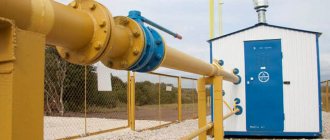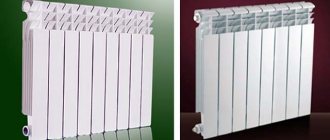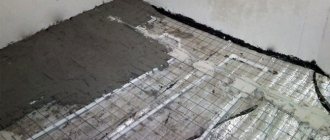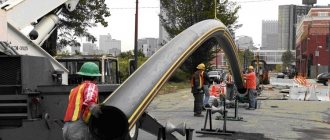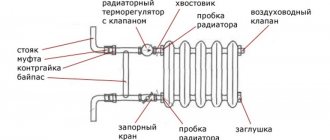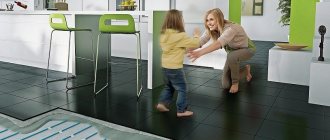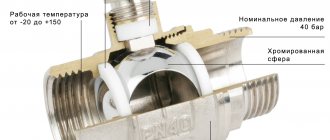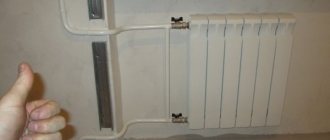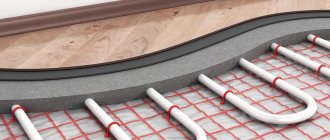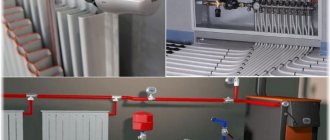Selection and marking of pipes
One of the advantages of this material is that it is almost not subject to thermal expansion due to its multilayer structure. How many layers are there in a pipe? We can say that there are three, with the middle one being made of aluminum. And if you also take into account the adhesive layers, then you get five.
The temperature limit that such pipes can withstand is 95°C. Therefore, they are suitable for operation at temperatures maintained in heating systems of private houses.
Before buying pipes, you need to decide what type of boiler is proposed to be used in order to select the diameter depending on the characteristics of the installation. Modern systems use pipes with a diameter of 16 to 63 mm.
You also need to determine the type of plastic used. All parameters and characteristics can be determined by the markings applied to the outer wall of the pipe. The data sequence has different meanings for different manufacturers, but they all contain the following information:
- Name of the manufacturer. In order for the system to operate with maximum reliability, it is recommended to choose pipes from Western manufacturers
- Material type. Pipes can be made of polypropylene (designated PP-R), high-strength polyethylene (PE-R) or cross-linked polyethylene (PE-X)
- Dimensions. They are indicated in millimeters. When calculating hydraulic pressure, it must be taken into account that with the same outer diameter, the actual inner diameter differs for different types of pipes, since the walls of metal-plastic communications are much thinner than those of polypropylene products
- Pressure withstand. This parameter indicates what operating pressure the pipe can withstand at a temperature of +20°C
The average withstand pressure is 20 atmospheres. Under such conditions, pipes can last up to fifty years. But you shouldn’t expect that they will last as long at a pressure of 2 MPa and a temperature of +95°C. In central heating systems, operating pressure can reach 7 atmospheres.
Information from the marking will be required when passing hydraulic tests, during which cold media is introduced into the system and the pressure is artificially increased.
Do-it-yourself heating from metal-plastic pipes in a private house - Mwskins.ru
Device for saving electricity Electricity Saving Box You can read reviews here
Correctly selected material for making pipes for organizing heating is the basis for the efficiency of the entire system. Until recently, there was no particular alternative - steel lines had to be installed. However, with the development of the polymer industry, it has become important to do heating with metal-plastic pipes in a private house with your own hands.
Features of metal-plastic for heating
Metal-plastic pipe design
The main performance qualities of heating pipes are a long service life with periodic temperature fluctuations, as well as minimal heat losses. These parameters are fully met by heating using metal-plastic pipes. A distinctive feature of these designs is the use of several materials that are different in nature and properties to achieve the required result.
The main manufacturing material is often cross-linked high-density polyethylene. But besides it, simple polyethylene or propylene can be used. To prevent oxygen molecules from entering the coolant, the pipe has a layer of foil. They are attached to the outer and inner polymer shell using an adhesive layer. This is a mandatory condition, since it is impossible to make effective heating from metal-plastic with your own hands from highways without a waterproof shell. Otherwise, supersaturation of water with oxygen will lead to an increased rate of corrosion of the metal elements of the system.
What is important for the consumer is not the technical, but the operational properties of heating pipes. Therefore, we will not consider the manufacturing technology in detail, but will focus on special aspects of metal-plastic:
Electricity Saving Box Electricity Saving Box Read reviews here
- What is better to take - cross-linked polyethylene for heating or metal-plastic? The latter has varying degrees of thermal expansion of its elements - polymer shells and foil layer. Therefore, on long sections of the pipeline it is necessary to install compensation loops;
- The operating temperature is limited to 95°C. Exceeding this value will lead to deformation of the structure;
- To connect the elements of the highway, you can use several types of fittings - glued, threaded or clamped. If you need to make reliable heating of a private house with metal-plastic, it is recommended to use the latter type of connectors.
What else is the difference when choosing - metal-plastic or polypropylene for heating? Easy to install first. To connect polypropylene pipes, a special welding machine is required. Metal-plastic pipes are installed using a pipe “gas” wrench. But the requirements for professionalism in their installation are much higher. Its reliability will depend on the degree of effort applied, the correct cut and drawing up the heating scheme.
A metal-plastic pipe can be bent to a radius of 12 mm. This applies to models whose diameter is 20 mm or less. As the cross-section increases, the minimum bending radius increases. This must be taken into account during installation.
Selection of pipes and components for the heating system
Table of dependence of water consumption on the diameter of the heating line
To organize heating from metal-plastic with your own hands, you need to choose the right pipes and components. First of all, the optimal diameter is determined - the throughput of the system will depend on it.
Metal-plastic pipes
What is more convenient for heating installation - metal-plastic or polypropylene? Metal-plastic pipes are supplied in coils, the length of which ranges from 50 to 200 m. Polypropylene products are manufactured in lengths up to 6 m. Also, when choosing a material for making heating from metal-plastic pipes, you need to take into account their quality, namely:
- The minimum thickness of the foil shell should be 0.3 mm;
- The connection of the aluminum layer must be carried out using seamless technology;
- There should be no delamination on the pipe cut.
It is imperative to ensure that there are no bends in the bay. This may affect the integrity of the aluminum shell.
Pipes from Rehau, Oventrop and Henko are distinguished by a high degree of reliability. In their product range you can select fittings and other additional components for the pipeline.
Fittings for metal-plastic pipes
Types of fittings for metal-plastic pipes
It is best to use press fittings for connections. They have the same design regardless of what was chosen - cross-linked polyethylene for heating or similar metal-plastic.
Models with a double seal circuit have the best performance characteristics. They are made of stainless steel and copper alloy (brass). The latter are characterized by a more affordable cost, but have a shorter maintenance-free service life.
An important factor when organizing heating of a private house with metal-plastic is the cost of components. This parameter directly depends on the manufacturer, as well as the technical characteristics of the elements.
If the main parameter for choosing metal-plastic or polypropylene for a heating system is the cost of components, then the first will “lose.” This is due to high labor costs during production.
The labeling must indicate that the product can be used in heating systems. Not all metal-plastic pipes are designed for high temperatures.
Installation of heating from metal-plastic pipes
Calibrator for metal-plastic pipes
To install metal-plastic heating yourself, you need to purchase special cutting scissors and a calibrator. It is designed to align the end of the pipe before installation into the clamp fitting. It’s not difficult to make it yourself, but there is a high probability of making a mistake in size - the permissible deviation is 0.5 mm.
After purchasing, the pipes must lie in a room with normal temperature (from 15 to 25°C) for at least 1 day. If you need to bend the line in a certain area, purchase a special spring.
Having cut the pipe to the required size, you should clean its end. Then the fitting is installed and clamped with a pipe wrench. The force should be relatively small so as not to damage the fitting body. To attach to a wall or floor, you need to use special clips.
Another difference between cross-linked polyethylene for heating and metal-plastic is the mandatory check of connecting nodes before starting the heating system. During pressure surges, they may lose their tightness or even collapse.
In the video you can get acquainted with recommendations for installing metal-plastic pipes:
mwskins.ru
Fittings and connection method
For metal-plastic pipes, two types of connections are used during installation: clamping and sliding.
- The clamping connection is made using an O-ring with a connector, which is called a collet. When the nut is tightened, pressure is created on the ring, it contracts and encloses the contour. To ensure strength and reliability, the shanks have a pair of rubber O-rings. In this case, it is always possible to disassemble the connections for repairs
- The sliding connection is permanent, that is, it cannot be dismantled. The fitting is fixed with a ring inside the pipe. The press ring used coincides in width with the length of the shank and is clamped by crimping using a specialized press
In addition to reviews about pipes, experts on websites leave recommendations on connection methods. Most people prefer to use press fittings.
Installation features
When equipping heating systems, metal-plastic pipes are used for:
- carrying out the main line to which heat-releasing devices will be connected,
- "warm floor" system devices.
We recommend that you read: How to properly install a chimney in a bathhouse through the ceiling and roof
Installation procedure
In both cases, the general procedure is as follows:
- Markings are applied along the surface along which the pipeline will be laid.
- Cut the pipes into pieces of the required length.
- Lay the pipes according to the markings.
- The pipes are connected with fittings. For hidden installation, inspection windows are installed at the connection points.
- They are fixed to the surface using clips, clamps or, in the case of heated floors, in special backing mats.
- If necessary, finish the surface along which the pipeline is laid. The grooves are closed if the pipes are laid in the walls or ceiling, and the floor is screeded if the heating circuit is laid horizontally.
The bending and joining of pipes has special features, since these operations are of particular importance for the installation and subsequent operation of the pipeline.
How to bend a pipe
There are three ways to rotate or rotate a metal-plastic pipe:
- Manually without auxiliary tools. The pipe is clasped with your hands so that the thumbs located along it are directed towards each other. Bend the pipe slightly and move your hands a couple of centimeters to the side, after which the operation is repeated. So, gradually, in small steps, the desired bend shape is obtained. Achieving accuracy this way is difficult, and pipes often break.
- Manually with auxiliary tools and materials. You can pour sand into the pipe and pull a thick, rigid wire or spring through it. Such filling will allow the effort exerted by a person to be distributed and will prevent the pipe from breaking. Next, the pipe is bent in the same way in small steps; especially strong pipe products are fixed in a vice and only then they begin to bend.
- Using a pipe bender. There are several options for this tool: manual, electric, hydraulic. In a pipe bender, the pipe is clamped between the sole and the rollers: the rollers hold it, and the sole pushes it outward, which is why bending occurs. As with the manual method, it will not be possible to give the pipe the required shape in one go; you will need to perform the operation step by step, bending the pipe at several points. However, a pipe bender will significantly speed up this process and save effort.
How to connect with clamp fittings
For high-quality assembly of a metal-plastic pipe system, it is necessary to use not only the highest quality materials, but also professional tools. If you try to make do with cheaper materials, it will be quite difficult to ensure that there are no leaks. As a result, the system will not withstand even several years of operation. High quality tools and good use of them are the key to reliable assembly.
To work with communications you will definitely need:
- Shears for pipes made of metal-plastic or plastic
- Shaver for shaping the seat and chamfering
- Open-end wrenches in assortment
Old-style shavers were used not only to chamfer, but also to calibrate pipes. However, because of this, the fittings, even in the highest quality pipes, were not tight enough, not providing the necessary reliability of the connection. Modern tools only remove the chamfer and give the desired shape to the contour.
If installed incorrectly, after two to three years of use, the pressed fittings have to be tightened due to leaks. When installing heating, the following points must be taken into account:
- For cutting, you need scissors suitable for pipes of a certain diameter. After using any type of hacksaw, rough edges remain on the cutting line. Even after cleaning it is impossible to obtain a completely flat surface. Scissors leave an even and smooth cut
- Before installing the fastener, you must remove the chamfer. Otherwise, the sealing gaskets on the shanks may break. New types of shaver should also be used
- When installing a collet seal, you need to carefully monitor the behavior of the collet. If the joint is pinched, this ring can be squeezed into the gap between the contour and the nut. As a result, the ring will pinch the thread
It is not recommended to save on materials or rush, then the quality of the heating circuit will ensure its long-term and reliable operation. In the future, when using the system, mechanical loads should be avoided. This is especially true if there are children in the house.
The advantage of using metal-plastic is ease of installation. But to achieve a certain level of quality, you need to hire professional performers or purchase high-end instruments, which are quite expensive. But if you do not do this, you will have to regularly, before each heating season, devote time to inspecting, repairing and adjusting the system.
Installation using press fittings
The use of pressed connections ensures reliable fastening of all elements. For this reason, metal-plastic pipes for heating occupy a sought-after niche in the market. But in addition to the usual tools, in this case you will need a special press for installation. Only a high-quality tool will ensure a strong connection, and the cost of the press and the necessary attachments reaches 2.5 thousand euros. This immediately significantly increases the cost of the work if you plan to do everything yourself.
The installation itself is quite simple. To work you need:
- Measure, cut and calibrate pipeline sections
- Chamfer
- Place a ring on the pipe
- Insert the fitting into place
- Using a press, tighten the connection, ensuring its tightness and tightness.
Connections of this type are non-separable, but you can verify the quality of the work done visually - you can check that the fitting is seated all the way using specially equipped holes. The only drawback of this method is that it is demanding on the quality of the press used.
Connection methods
There are several ways to connect such pipes; two main ones are used for heating systems:
- using compression fittings;
- using press fittings.
The first method is good because the use of compression fittings greatly simplifies all work. These fittings do not require any special tools, with the exception of the aforementioned scissors.
In addition to these, you may need:
- a set of open-end wrenches or an adjustable wrench;
- FUM tape;
- calibrator
FUM tape can be replaced with regular tow with a special sealant.
As for fittings, they can be of various shapes:
- corners;
- tees;
- adapters and so on.
All fittings have a fitting at their end that contains one or more O-rings. In addition, there is a clamping ring and a union nut, which presses the pipe and fitting together.
Before connecting the pipe and fitting, the ring and nut from this fitting are put on the pipe. Now you need a calibrator. It serves to create an even round shape at the end of the pipe. If this shape is not in place, then during the process of securing the fitting and pipe, the O-rings on the fitting may simply become damaged, which will lead to a leak.
After calibration, the pipe is put on the fitting. Next, the clamping ring and the union nut are pulled into place, which is screwed along the thread until it stops. Tow or FUM tape is pre-wound on the ring.
The nut is tightened with not very much effort. If you apply too much force, the nut will simply burst or strip the thread. Tightening should be continued until a characteristic metal squeak appears.
Related article: How to make a solar oven
Regarding the use of press fittings, installation can be divided into two types, although the division should be considered conditional:
- using crimp couplings;
- using press fittings.
This method requires a special tool, for example, press jaws. Such a tool can be mechanical or hydraulic. It is worth noting that each type of press fitting requires the use of its own type of tool, which differs in design and principle of operation. For example, push-on press fittings require a special expander.
In addition to this tool, you will also need the one listed above.
Requirements for pipes when installing “warm floors”
One of the important points when using plastic and metal-plastic systems is the minimum number of circuit breaks during installation. This primarily applies to “warm floors”, although this requirement must also be taken into account when installing conventional heating systems. Pipes bend easily, so when turning, you should not use adapters, as is done with metal pipes. There should be no connections left under the screed - only an unbroken section.
When laying, “snake” or “shell” patterns can be used. In the second option, the bends are softer, and fewer turns of 90 or 180 degrees are needed, like a “snake”. Before screeding, you need to check that the contour evenly covers the entire floor and that an equal distance is maintained between the elements. And then secure the contour with plastic clips and check.
The underfloor heating system is being used more and more often; it is successfully replacing traditional radiator heating. And metal-plastic pipes are best suited for it.
Can you trust metal-plastic?
Today, debates are still ongoing about which pipes are more reliable for heating systems - polypropylene or metal-plastic. Although their mechanical and thermal resistance is approximately the same, the question most often lies in the joining method used.
Plastic systems use welded joints. They are more airtight than push-out fittings. But if you install compression fittings, then metal plastic has significant advantages. The fact is that in the process of welding polyethylene it is necessary to very accurately maintain the temperature regime. When underheating or overheating, the quality of the connection is impaired. In addition, if the connection is incorrect, melted plastic can narrow the passage. The use of fittings also narrows the cross-section of the pipe, but not as much as soldering errors.
The resulting cost of a system assembled using metal-plastic elements will be slightly higher, not so much because of the price of the pipes, but because of the costs of fittings and adapters. But if all installation rules are followed, this system turns out to be more stable. It maintains the strength and tightness of the connections, and the expansion coefficient of such pipes is lower. In addition, you can always improve the system by adding new equipment.
Read other articles on this topic
| Heating a private house with electricity | Heating distribution for a two-story house |
| Autonomous heating of a private house | Infrared heating of houses |
| Gas consumption for heating a private house - consumption calculation | Heating system for a private house using a warm baseboard |
| Country house heating system | How to save on heating a country house |
| Heating diagram for a two-story house | Heating a private house with forced circulation |
| How to heat a private house | Heating the house with liquefied gas |
| Heating options for a frame house | How to heat your home without gas |
| Heating a private house with underfloor heating | Heating system for a private house with natural circulation |
| About heating schemes for a private house with a gas boiler | Heating a private house with convectors |
| Do-it-yourself heating of a private house made of polypropylene | Heating project for a private house |
| Combined heating system for a private house | Installation of a heating system in a private house |
| The best heating for a private home | Water heating in a private house |
| Heating and water supply of a country house: description of installation technology | Collector heating system for a private house |
| Features of heating a country house with electricity | Heating wiring diagrams from a boiler in a private house |
| Basic rules for the location of radiators when heating a private house | Installation of a heating system: rules and description |
| Heating your home is the most economical way | Heating a private house with a heat pump - pros and cons |
Services on this topic
| Heating design | Turnkey solid fuel heating |
| Turnkey gas heating | Turnkey heating |
| Heating in a turnkey wooden house | Turnkey water heated floor |
| Installation of water heated floor | Heating a two-story house |
| Heating installation in a cottage | Heating a country house: options and prices |
| Heating installation | Heating installation in a private house |
| Installation of plumbing and heating engineering systems | Diesel heating of a country house |
| Autonomous heating on a turnkey basis | Air heating of a country house |
| Prices for heating installation in a private house | Design and installation of heating systems |
| Water heating in a private house | Electric heating of a country house: options and prices |
| Heating in a townhouse | Gas heating design |
| Heating design cost | Heating calculator for a private house |
| Installation of water heated floors in a private house | Price for installing a water heated floor |
| Installation of water heated floors on a wooden floor |
